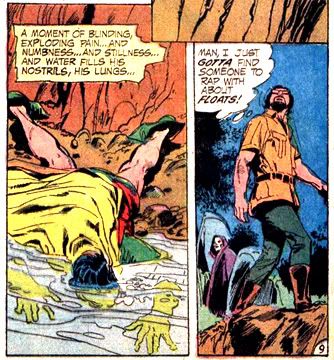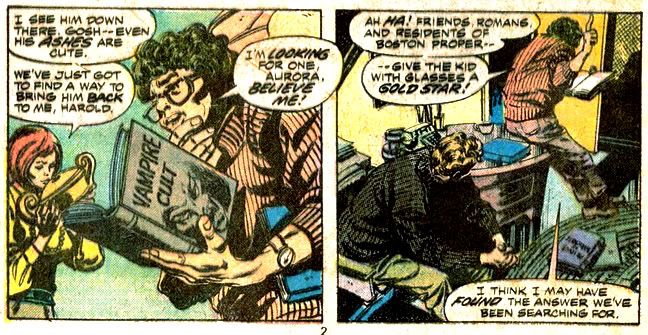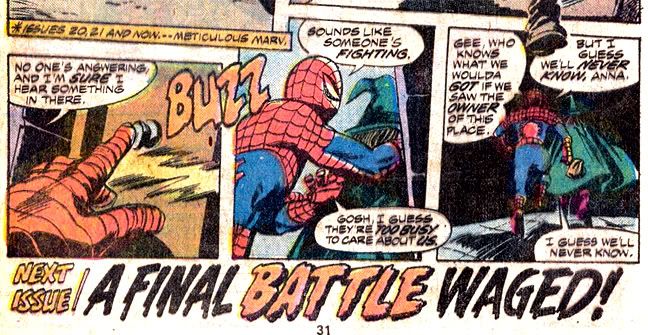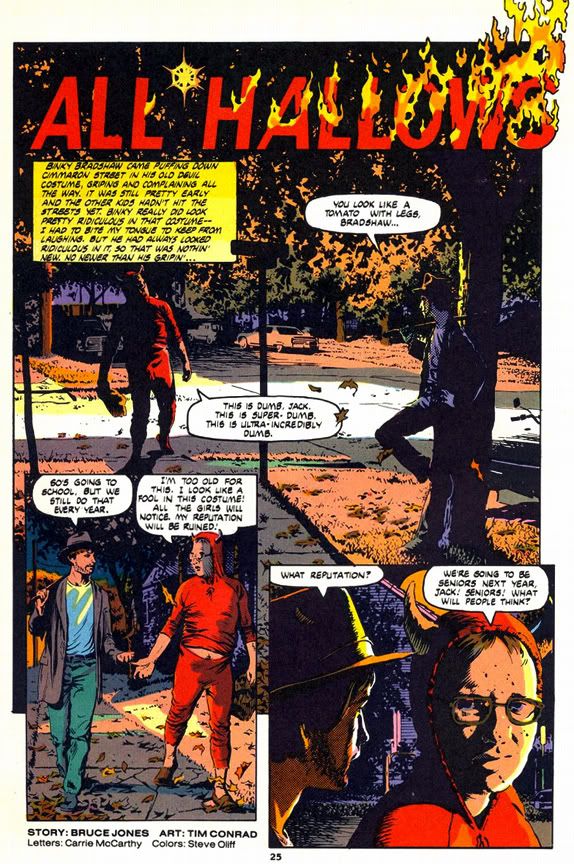 Here's a Halloween treat-- "Night of the Reaper," with Batman and Robin in Rutland, Vermont, for the annual Rutland Halloween Parade plus a swingin' shindig for all the groovy cats and chicks at superfan Tom Fagan's house. And more Nazis than you can shake a roll of Smarties at. Kids of all ages (and Nazi war criminals) love this classic candy treat.
Here's a Halloween treat-- "Night of the Reaper," with Batman and Robin in Rutland, Vermont, for the annual Rutland Halloween Parade plus a swingin' shindig for all the groovy cats and chicks at superfan Tom Fagan's house. And more Nazis than you can shake a roll of Smarties at. Kids of all ages (and Nazi war criminals) love this classic candy treat.Ah, what a pedigree this story has. The script is by Denny O'Neil "from an idea by Berni Wrightson with an assist from Harlan Ellison" and the art is by Neal Adams and Dick Giordano.
It opens with an eerily atmospheric splash page, a dark image of the lonely body of a dead Batman bathed in the light of a Halloween full moon. The narrative captions tell us a light is blinking on and off on top of the house in the background, but it's not visible.
What is visible, however, is Dick Grayson and his college pals on their road trip to Rutland. Since it's 1971, guys unashamedly stroll around in public wearing purple vests or full-on safari outfits and tall leather boots. Of course, it is Halloween. Dick's vest is only slightly more flamboyant than what the other revelers have on. Another clue that it's the 70s is Dick's nonchalant attitude towards one of his friend's possible drug use when someone mentions the guy's weird behavior:
"Right!... and gulping coffee and who-knows-what-else to keep his eyes open."
Dick, possession of schedule 1 narcotics is a crime. You're a crime-fighter. Why are you making with the quips when you should be punching this guy straight? I mean as Batman's partner should Robin be so casual about this one-man Fear and Loathing at the Rutland Halloween Parade?
I knew a guy in junior college who sold LSD to truck drivers who needed a little pick-me-up on cross-country hauls, so maybe this guy is tripping to stay awake. He seems intent on the parade floats in a manner consistent with hallucinogen use. But perhaps he's on methylamphetamines or PCP. Whatever's got him so twisted, Batman is going to be really disappointed his ward puts being a "big man on campus" ahead of doing his sworn duty as a superhero sidekick.
No matter. There's a party at Tom Fagan's! And as the bespectacled fellow in menacing black jackboots says, "Where a party is, girls is." Unless that party involves sausage, my friend. Ever been to one of those? Nothing but lighting farts and watching Rambo movies, not a girl in sight.
 Who is Tom Fagan? Tom Fagan was a real person, who lived in Rutland. He was a newspaper reporter and comic book fan who served as the Halloween parade's chairman. Fagan built the parade into a major event featuring floats from both Marvel and DC, and according to an October 2008 story in the Rutland Herald, 181 different comic characters at one point. A caption in the lower left corner of page two of this story promises "any similarity to actual persons or places depicted in this tale is probably a stranger tale than you'd ever really believe!"
Who is Tom Fagan? Tom Fagan was a real person, who lived in Rutland. He was a newspaper reporter and comic book fan who served as the Halloween parade's chairman. Fagan built the parade into a major event featuring floats from both Marvel and DC, and according to an October 2008 story in the Rutland Herald, 181 different comic characters at one point. A caption in the lower left corner of page two of this story promises "any similarity to actual persons or places depicted in this tale is probably a stranger tale than you'd ever really believe!"
Not really. Comic book companies send costumed representatives to a Halloween parade. Some of their employees and artists go there to enjoy the festivities. Wrightson and Ellison pitch a story about it, O'Neil writes it, Adams puts a lot of his young comic book proteges in the story, along with Tom Fagan himself. Cool, but far from strange.
But it sure makes it seem these comic book guys were living out wacky adventures beyond the ken of us fans, huh? I remember thinking so when I read this story in some reprint book years ago. Batman From the 30s to the 70s? The Greatest Batman Stories Ever Told? Oh, how I wanted to draw them funny books and go to Rutland in them thar days. But mah gold claim came a-cropper an' I had to change professions to muleskinnin' and then thar was mah stint dealin' faro in Tombstone. I remember when them Clantons threw down with the Earp brothers and Doc Holliday outside of Fly's Photography Studio...
 Where was I? Oh yeah, Rutland not the Old West. How often I get the two confused; they're quite similar. Since this is a Batman and Robin action joint and not a college romance or some kind of Cheech and Chong story, O'Neil quickly sends Dick Grayson into a fight. He spots a guy in a Robin outfit getting the snot beat out of him and-- imagining it's himself-- goes to help. The drugged-out safari guy blunders around, oblivious to the violence around him and causes Dick to take a blackjack to the skull. Recovering, Dick slips away from the DC arti-- er-- his college pals, switches to Robin and chases the thugs. But look!
Where was I? Oh yeah, Rutland not the Old West. How often I get the two confused; they're quite similar. Since this is a Batman and Robin action joint and not a college romance or some kind of Cheech and Chong story, O'Neil quickly sends Dick Grayson into a fight. He spots a guy in a Robin outfit getting the snot beat out of him and-- imagining it's himself-- goes to help. The drugged-out safari guy blunders around, oblivious to the violence around him and causes Dick to take a blackjack to the skull. Recovering, Dick slips away from the DC arti-- er-- his college pals, switches to Robin and chases the thugs. But look!
It's the dead Batman from the splash page! Robin mistakes the corpse for the real Batman:
 Then Robin gets his ass handed to him for the second time that night and falls into some kind of drainage ditch or broken sewer line:
Then Robin gets his ass handed to him for the second time that night and falls into some kind of drainage ditch or broken sewer line: Yes, for any purpose Robin is useless. Well, that's not true. He's good as a sparring partner because he's easy to beat. Managers of third rate boxers often hire him to build their fighters' confidence. I've never been a proponent of the sidekick, and this story illustrates why.
Yes, for any purpose Robin is useless. Well, that's not true. He's good as a sparring partner because he's easy to beat. Managers of third rate boxers often hire him to build their fighters' confidence. I've never been a proponent of the sidekick, and this story illustrates why.
And just as Robin drowns, our story's comedic relief passes by, hoping to discuss floats with someone, or in the parlance of the time, rap. He wants "to lay it on" someone, "to groove" and perhaps even "to grok." He would like "to talk turkey," without any "jive hassles" or "the Man coming down" on him. He wants to do these things with anyone but furtive little guys in purple robes. Those he ostracizes as unworthy of float-rapping. He's starting to remind me of that "Eat at Joe's" bear from the classic Tex Avery cartoon "Jerky Turkey."
Robin awakens upstairs at Tom Fagan's house and there's his old pal Batman and... GAAAAHHHH!
 Oh, sorry. It's just kindly Dr. Gruener. For a second there I thought Robin had died and that dessicated visage was the Grim Reaper. And here's where the plot kicks in. Gruener, a concentration camp survivor, recently spotted Nazi fugitive Colonel Kurt Schloss in Rutland. He reported the war criminal to the authorities and they sent Batman for some reason, instead of the FBI.
Oh, sorry. It's just kindly Dr. Gruener. For a second there I thought Robin had died and that dessicated visage was the Grim Reaper. And here's where the plot kicks in. Gruener, a concentration camp survivor, recently spotted Nazi fugitive Colonel Kurt Schloss in Rutland. He reported the war criminal to the authorities and they sent Batman for some reason, instead of the FBI. Now that Batman has shown up, O'Neil and Adams pay tribute to Tom Fagan buy having him meet the dread Batman himself. And Adams takes the opportunity to draw more friends and poke fun at the Distinguished Competition... wait. That's Marvel's name for DC, not the other way around. Anyway, here's a muscular oaf dressed like Thor with a colander on his head:
Now that Batman has shown up, O'Neil and Adams pay tribute to Tom Fagan buy having him meet the dread Batman himself. And Adams takes the opportunity to draw more friends and poke fun at the Distinguished Competition... wait. That's Marvel's name for DC, not the other way around. Anyway, here's a muscular oaf dressed like Thor with a colander on his head: When he gets off that guy's foot, he's going into the kitchen to strain spaghetti for the "dead witch" routine.
When he gets off that guy's foot, he's going into the kitchen to strain spaghetti for the "dead witch" routine.
The plot has to do with Nazi gold and an assassination attempt on Schloss by his former friends. Batman starts kicking ass and taking names, as Batman is wont to do. We even get an early iteration of the now-cliched "Batman threatens to kill a guy in a high place" scene, despite there being no record of Batman ever having actually killed anyone:
 There's a twist in that Dr. Gruener isn't exactly on the up-and-up and things get a bit dodgy plotwise. It starts off well: Robin's motivation for being in Rutland is natural; he's trying to have fun and meet some cute chicks. That Nazis are also in Rutland the very same night trying to kill one of their own (who conveniently loves costume parties) and this somehow means also murdering Batman and Robin or people dressed like them is overly coincidental.
There's a twist in that Dr. Gruener isn't exactly on the up-and-up and things get a bit dodgy plotwise. It starts off well: Robin's motivation for being in Rutland is natural; he's trying to have fun and meet some cute chicks. That Nazis are also in Rutland the very same night trying to kill one of their own (who conveniently loves costume parties) and this somehow means also murdering Batman and Robin or people dressed like them is overly coincidental.
I find that's frequently a problem with the Caped Crusader-- actually having a logical reason for him to investigate or otherwise involve himself in whatever crime is going on. You can't just have him overhear the criminals and jump off a rooftop onto them every time. Here, Batman has been sent on official business but the story turns on a surprisingly slapdash decision by one of the supporting characters that spoils its twist. At least we get one of those patented Denny O'Neil "Batman succeeds but he fails" downer endings. Batman in the 1970s was fallible and self-questioning and a whole hell of a lot more likable than the more recent version, who I find reprehensible and random.
But despite some awkward turns this story is a lot of fun, especially around Halloween time. You can find it reprinted in Batman Illustrated by Neal Adams volume three.
















